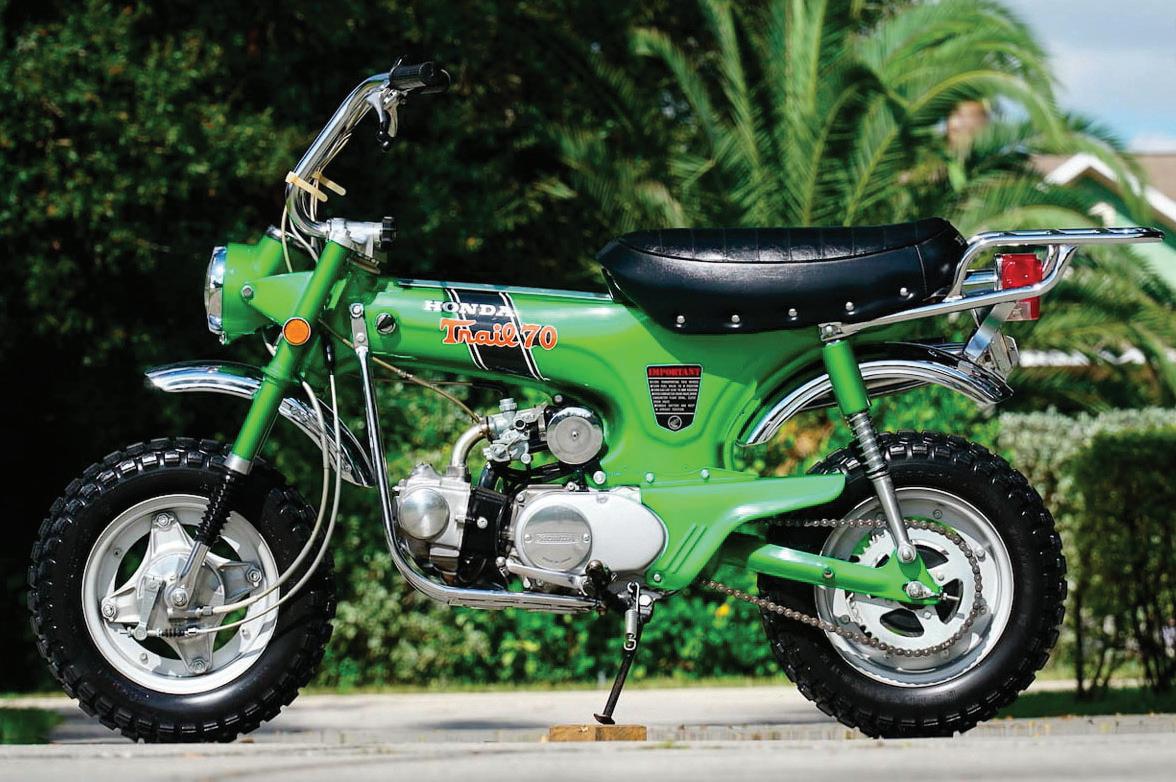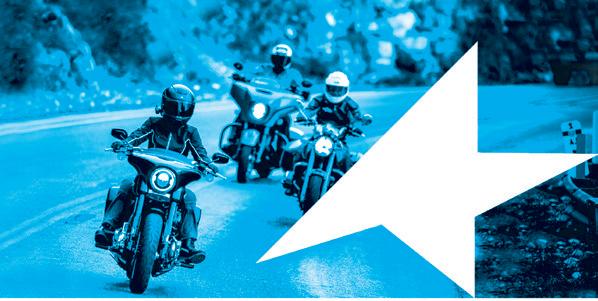
9 minute read
MEGAPHONE
MEGAPHONE TIME MACHINES
BY FRANK LENNOX
T

he 1960s and ’70s were an amazing time for motorcycling, and a wondrous period in which to learn to ride — as so many of us did on the dirt- and minibikes of the day. Looking around at local off-road events and organized rides, I know I’m not the only one who feels that way. Seems we all got bitten by the same bug all those years ago; a bunch of 50- and 60-plus-year-olds that won’t stop riding despite the inevitable effects of aging.
Maybe it was because we grew up without video games and consumer electronics, or because “connectivity” was defined by the distance that could be reached by a CB radio (“breaker, breaker, good buddy…”), but learning to ride back then burned a passion into my brain that has lasted all my life.
My story started like a lot of others, I’m sure, when a childhood friend got a brand-new 1972 Honda Z50A Mini Trail for his 10th birthday. Summer days and the question “What do you want to do today?” came to a screeching halt the moment he let me take the Mini Trail for my first ride.
After that ride I started an all-out campaign to acquire a minibike of my own, covering my bedroom walls with dirt bike brochures, posters, magazine pages and whatever else I could find. My parents couldn’t walk into my room without being assaulted by Honda SL70s and SL100s, Yamaha Mini Enduros, and the soonto-be-released GT80 (I so wanted one!), Hodaka Super Rats and more.
They weren’t falling for it, so if my words and pictures could not sway them, surely my new full-face helmet, purchased out of the JC Whitney catalog, would. I was certain my parents would recognize how responsible I was to have saved so hard for the purchase of safety equipment, though I didn’t even own a motorcycle.
But even after months of trying, I was getting nowhere. I remember my mother, frustrated with my persistence, saying “You’ll never own a motorcycle as long as you live under our roof.” There was finality to the words and tone that shook my will. I remember fighting back tears when my older sister, who’d overheard the conversation, whispered “Don’t give up. Keep talking about bikes, keep getting the magazines, keep riding your friend’s bikes.” She rode horses and had competed in 4H events for as long as I remembered, but I never knew exactly how she convinced my parents to let her get her first horse. Apparently, she had been through a similar struggle and offered the advice that had paid off for her.
With newfound conviction, I continued. It must have been obvious to my parents that the day I turned 18 I would buy a motorcycle and, if need be, live on the street. One day my father told me that a co-worker’s son was selling a motorcycle. Would I like to take a look at it?
Are you kidding me!? I asked him a million questions on the drive there, but it was obvious my father had no idea what we were going to see. It could have been that shiny new Yamaha 80 or a ratted-out Rupp with a 3.5-hp Briggs & Stratton, but one Frank Lennox is an thing was for sure: I was going to tell AMA Member. him it was perfect and that I had to have it!

Honda’s CT70… an epic mini if ever there was one.
The owner lifted the garage door and in a dark corner I spied a basket-case Honda CT70 lying on its side. What I couldn’t see is that this machine would turn out to be so much greater than the sum of its parts. And there were a lot of parts! I waited an excruciating month for a local fix-it guy to finally get it assembled and running. Ahhh, yes! It was summer, I was 12 and I had my own dirt bike! I was free to go anywhere the bike could take me, and if my parents knew where I went and what I did with that bike, they would have chained it to a tree. And that’s a lot of the reason all of us old-timers defy our aging bodies and continue to ride in the dirt…and why swinging a leg over a dirt bike — no matter how old you are — brings back the excitement and wonder of our youth. Back in a time when we were trying to understand our place in the world, those dirt- and minibikes helped take us there. And still do.

BACKFIRES
MORE CARLSBAD
Thanks for the Sacred Ground piece in the June edition. I was 17 that summer and barely managing to complete U.S. Marine Corps Infantry Training at nearby Camp Pendleton, Calif. The school reluctantly gave us weekend passes, and when I noticed a poster on base advertising the 1980 USGP, I couldn’t believe my eyes. I’d raced motocross growing up in Boise, Idaho, and managed to talk a fellow Marine into going there with me that hot summer day in June. We took a city bus from the base and hiked from the main road alongside more people in one place than I had ever seen. I will never forget how smooth those gritty men riding 500cc machines flew past us. Today, while trying to catch my breath and wipe the sweat off after a practice moto at our local track here in Arizona, I heard guys complaining about the track…not prepped good enough or watered properly. I didn’t say a word, and quietly remembered those ironmen on the gas at the USGP flying up the Carlsbad Freeway.
Jim Crowell USMC (Ret.) AMA #781952
Thanks for the letter, Jim, and more importantly, thank you for your service! —Ed.
Each issue keeps getting better! American Motorcyclist is my favorite magazine, and the Carlsbad issue is the best yet. I’ve been taking it easy, on the mend from open heart surgery, and AM helped me get through a few of those challenging days. Thanks for all you do!
Al Banta
CHECK YOUR SIX
Good article (Checking Your Six, June 2022), but there is now another piece of technology that greatly adds to rear-end safety. For some time a particular company has sold a helmet-mounted brake light, though it requires being wired into your bike’s electrical system. There is now one called Brake Free (brakefreetech. com) that’s totally self-contained, requires no wiring, easily attaches and detaches from the back of your helmet, has a choice of changeable modes, and uses a built-in rechargeable battery that’s good for all day. Not sure on the science, but according to the literature it uses onboard sensors to activate when braking, decelerating and downshifting, and uses a different flash pattern when emergency braking. I’ve ridden a couple thousand miles with it and the difference was immediately noticeable. Most cage drivers won’t even stop close to me at stop lights. Total price (including tax & shipping) is $169.99. Not cheap, but excellent quality and, more importantly, it works.
Mike Watts
The Checking Your Six article was accurate and well-written but it did not go far enough. So here are some additional suggestions taught to me many years ago by the then head of the Oklahoma Highway Patrol Motorcycle Unit, Bob: 1. Every time you prepare to stop, think about what you can do in that particular situation to keep from being hit from behind. 2. As you prepare to stop, transition from using both brakes and only use the footbrake, keeping your right hand ready on the throttle
LETTER OF THE MONTH

SACRED GROUND
Liked the Carlsbad piece, as it was also the home of the Four Stroke MX Nationals. This is me on my customframed XL350 Honda. It was a boredand-stroked (to 450cc) XL engine in an Elsinore frame with the engine cradle cut out. C&J in Santa Ana built a new cradle, Long Beach Honda stroked the crank, Powroll supplied the piston, and Q&E Engineering in Anaheim did the bore job. Ran laid-down FOX shocks, too. Even with the upgraded shocks Carlsbad was a handful, and I spent more time in the air than gaining traction to the ground. The bike ran well and maybe I was ahead of my time with the all-Honda chassis and 4-stroke power in an MX bike! It was heavy, but once it hooked up, watch out. That’s the late, great Mike Bell in the background in the red striped shirt and his dad, Bill Bell, standing next to him.
Ron Farkas, Charter Life member
Letters to the editor are the opinions of the AMA members who write them. Inclusion here does not imply they reflect the positions of the AMA, its staff or board. Agree? Disagree? Let us know. Send letters to submissions@ama-cycle.org or mail to American Motorcyclist Association, 13515 Yarmouth Drive, Pickerington, OH 43147. Letters may be edited for clarity and brevity.
(and your eyes on your mirrors) to pull away if necessary. 3. Position the bike with an “escape route,” either between cars or off the road in the event you detect someone who’s not going to stop. 4. As you come to a stop, only put your left foot on the pavement so you can keep your footbrake on and the brake light lit. 5. Keep the bike in first gear with the clutch in and continue watching your mirrors. 6. Listen for telltale sounds that may indicate someone behind you has lost control or is braking very hard and may not stop in time. You may have to turn down your infotainment system and avoid listening to your own exhaust pipes.
If someone appears to be unable to stop in time to avoid a rear-end collision, you have already planned your escape route, you are already in gear and you have your hand on the throttle…so you may save a couple of seconds, which may be enough. Bob’s final advice to new riders is to look at how professional motor officers approach a stoplight. They will not put down both feet and sit in neutral. There is a reason.
Bill Faris
All good info, Bill. Thanks for adding to the discussion. —Ed
EVEN MORE PERIL
Great issue, as always, especially Michael Sayre’s sobering article, Partially Automated Peril. I’ve been riding on-road since 1956, when I got my license, and I have never been so nervous about traffic as I am now, 66 years later. Six levels of automation in vehicles (cars and trucks)? Absurd! There should be none! The driver should always been in total charge. I am all in favor of devices that can make the drive safer, like automatic braking systems in case the driver dumbs out. But as an old-fashioned guy I believe that human beings should be better drivers than any electronic gadgets. Especially when it comes to pedestrians and motorcyclists.
Clement Salvadori AMA #77415
Agree! You go, Clem! —Ed.








